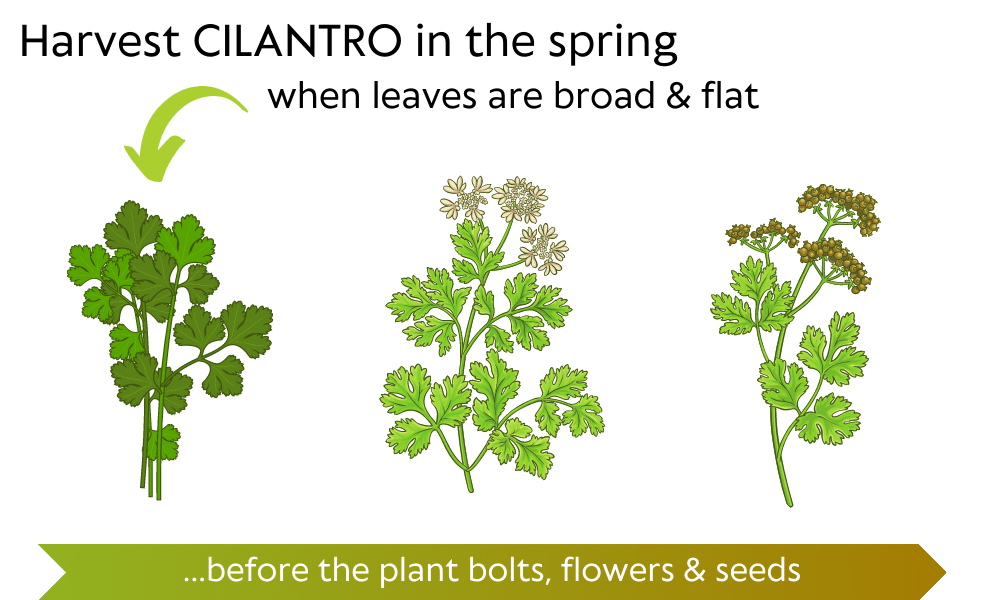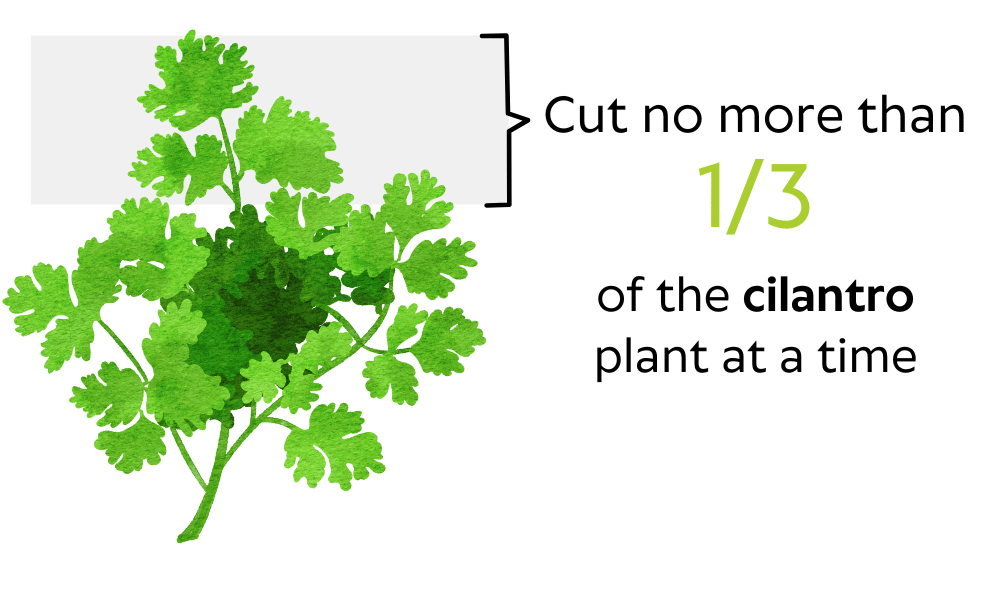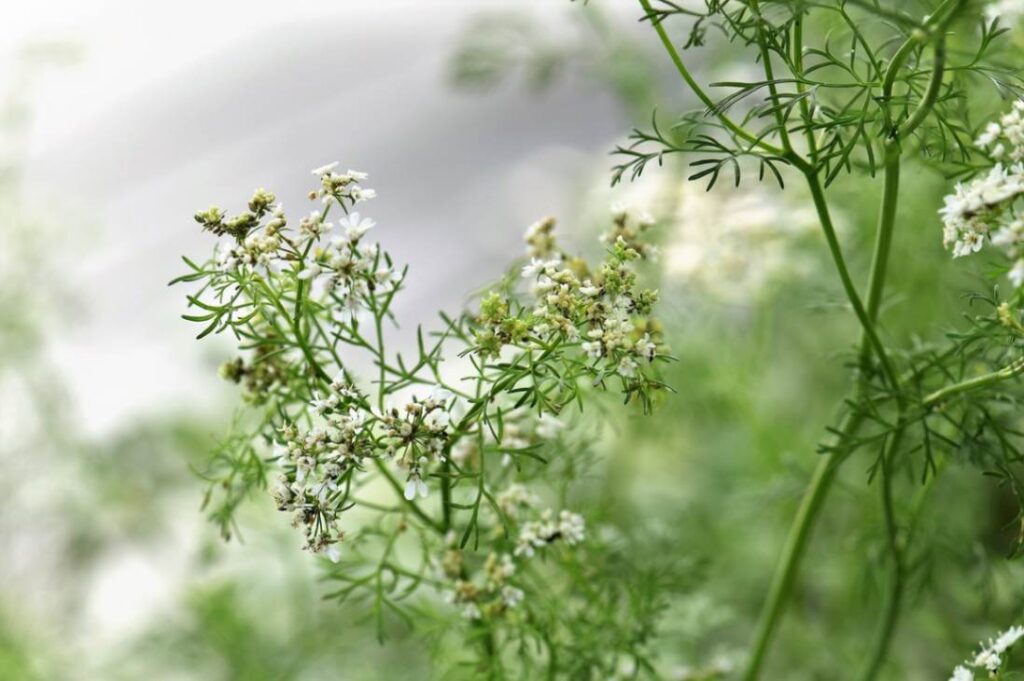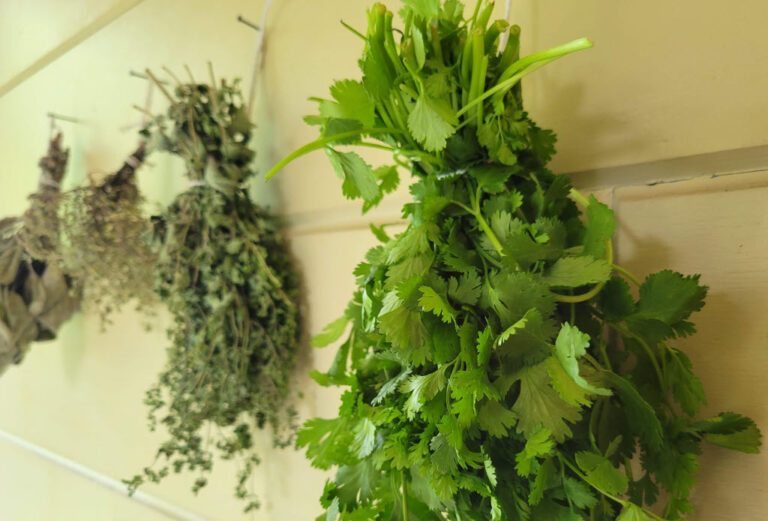This post may contain affiliate links which means I may receive a commission for purchases made through links. I only recommend products that I have personally used. As an Amazon Associate I earn from qualifying purchases. Learn more on my Private Policy page.

Cilantro is a versatile and fast-growing herb that adds freshness and vibrancy to countless culinary creations like salsa and guacamole. Knowing how to properly harvest cilantro without killing the plant is crucial for continuous harvesting.
To harvest cilantro without harming the plant, regularly pick small amounts throughout the growing season and avoid overharvesting. It’s best to pick cilantro leaves in the morning when they are crisp and flavorful, avoiding the afternoon or evening when the plant may be stressed from heat.
Table of Contents
Determining When Cilantro is Ready to be Picked
Harvesting cilantro at the right time ensures that you get the most flavor and freshness. Let’s explore some key indicators that will help you determine the perfect time to harvest your cilantro.
Cilantro should be harvested 4 to 6 weeks after planting when the plants reach 6-8 inches in height and have tender green leaves. Harvesting should be done before the plant bolts and transitions into the flowering stage, as the leaves become bitter and less flavorful.
Understanding Cilantro’s Growing Preferences
Cilantro thrives best in cooler weather, particularly during spring and fall seasons. During these periods, cilantro exhibits its full potential, producing lush and broad flat leaves. High temperatures cause the plant to prematurely shift into the flowering stage, leading to bitter-tasting leaves.
Avoiding Summer Heat
Cilantro tends to bolt quickly as the temperatures rise in the summer. This bolting process often results in lacy and fern-like leaves along the flower stalk, which are less desirable for harvesting due to their bitterness. Once cilantro bolts, it begins to flower and “go to seed,” which is when coriander seeds will develop.

When is the Ideal Harvesting Time for Cilantro?
The ideal time window to begin harvesting cilantro is when the plants have reached about 6 inches in height and exhibit tender green leaves. This stage typically occurs within 4 to 6 weeks after planting, although it may vary depending on growing conditions such as temperature, sunlight, and soil quality.
Recognizing Leaf Characteristics
The broad, flat leaves that emerge during the early growth stages are the most desirable for culinary purposes. These leaves possess the characteristic fresh and citrusy flavor that cilantro is known for, adding a delightful touch to dishes. As the plant bolts and transitions into the flowering stage, the leaves become more delicate and fern-like, losing some of their flavor and developing a bitter taste.
How to Harvest Cilantro Without Killing the Plant
To harvest cilantro without killing the plant, regularly pick small amounts throughout the season, avoid overharvesting, and ideally do the picking in the morning when the leaves are most fresh and flavorful.
To maintain a constant supply of cilantro, it’s advisable to pick smaller amounts fairly regularly throughout the growing season, allowing the plant to keep producing new foliage.

Never harvest more than one-third of your cilantro plant at a time. Overharvesting can hamper the plant’s growth, so it’s important not to take too much at once and leave enough leaves for photosynthesis and for future growth. It’s best to stagger the picking times across the season rather than harvesting all at once.
Preserving Fresh Cilantro
There are several methods for preserving fresh herbs like cilantro, allowing you to enjoy its vibrant flavor and aroma for longer periods. Let’s explore some effective techniques.
Water Bouquet Refrigerator Method
One simple way to extend the shelf life of fresh cilantro is by storing it as a bouquet in water in the refrigerator. Start by trimming the stems of your cilantro bunch and removing any wilted leaves. Place the trimmed cilantro stems in a jar filled with water similar to the way you would with fresh-cut flowers, ensuring they are submerged several inches. Loosely cover the jar with a plastic bag and store it in the refrigerator.

To maintain freshness, remember to change the water every few days or whenever it appears cloudy. This method helps keep the cilantro hydrated and prevents wilting for up to 10 days.
Storing Cilantro in Damp Paper Towels
Another popular technique for preserving fresh cilantro involves using paper towels. Begin by washing and thoroughly drying your cilantro leaves. Take damp paper towels and wrap them around the bunch of cilantro, gently pressing down to ensure good contact between the leaves and the paper towel.
Place this wrapped bundle into a plastic bag, leaving some air inside but sealing it tightly. By doing so, you create an environment that helps retain moisture within the herbs while preventing excessive condensation. Store this bag in your refrigerator’s crisper drawer for optimal results.
Preserving Cilantro with Herb Keepers
If you frequently use fresh herbs, investing in an herb keeper can be a game-changer. These specially designed containers come with a water reservoir that helps maintain moisture levels, extending the lifespan of herbs like cilantro.
To store cilantro in an herb keeper, trim the stems and place them in the designated compartment. Fill the reservoir with water and ensure it is regularly replenished. This method keeps your cilantro hydrated and crisp, allowing you to enjoy its flavor for up to two weeks or longer.
Whether you opt for refrigeration, paper towel wrapping, or an herb keeper, each technique offers a simple yet effective way to extend the shelf life of your cilantro leaves and flowers. So go ahead and stock up on this flavorful herb without worrying about it spoiling too soon!
Drying Cilantro for Long-Term Storage
Drying cilantro is a great way to preserve its vibrant flavor and extend its shelf life.
Hanging Cilantro to Dry
One popular technique for drying cilantro is by hanging it upside down in a well-ventilated area. Start by tying the cilantro stems together with a string, creating small bundles. Hang these bundles in a cool, dry place away from direct sunlight. This method allows the air to circulate around the herbs, aiding in drying.
Allow the cilantro to air dry completely until the leaves crumble easily between your fingers. The duration may vary depending on factors such as humidity levels and temperature. It usually takes about one to two weeks for cilantro to fully dry using this method.
Dry Cilantro with a Food Dehydrator
If you prefer a faster drying method, consider using a food dehydrator. Spread out the cilantro leaves on the dehydrator trays, ensuring they are not overlapping. Set the dehydrator at a low temperature (around 95°F/35°C) and let it run until the leaves are crispy and brittle. This typically takes about four to six hours.
Shelf Life of Dried Cilantro
If stored correctly, dried cilantro can retain its flavor for up to six months. However, for optimal flavor, it is recommended to use it within the first few months after drying. As time goes by, the potency of the herb may gradually diminish.
By drying cilantro, you can have a readily available supply of this versatile herb throughout the year.
Proper Methods for Storing Cilantro
Storing cilantro properly is crucial to ensure its freshness and potency for future use. By following these simple guidelines, you can maintain the flavor and aroma of your cilantro for an extended period.
Store dried cilantro in airtight containers
Using airtight containers is essential for storing dried cilantro, as this prevents moisture from seeping in and maintains the herb’s quality. Choose glass or plastic containers with tight-fitting lids to keep your dried cilantro fresh. Using vacuum storage bags is another great option for storing dried cilantro, as it maximizes the amount of air removed.
Keep in a cool, dark place
To preserve the potency of your dried cilantro, store it in a cool and dark place. Heat exposure can lead to flavor loss. Avoid placing it near heat sources like stoves or ovens, as this may compromise its quality over time.
Regularly check for moisture or mold
It’s important to inspect your stored herbs periodically for any signs of moisture or mold growth. Even with proper storage techniques, there is still a chance that humidity could affect the quality of your dried cilantro. If you notice any dampness or mold formation, discard the affected portion immediately.
By following these proper storage methods for cilantro, whether dried or fresh, you can extend its shelf life and enjoy its vibrant flavors for an extended period.
Harvesting Coriander Seeds from Cilantro Plants
What is the difference between Cilantro and Coriander? Cilantro refers to the fresh leaves and stems of the plant, while coriander refers to the dried seeds of the same plant. While most people are familiar with using cilantro leaves in their dishes, the coriander seeds can also be harvested and used as a spice.

Allowing Cilantro Plants to Flower and Produce Seeds
To harvest coriander seeds, it is essential to allow some of your cilantro plants to flower and produce seeds. When the cilantro plant reaches maturity, it will send up tall stalks with small white flowers. These flowers eventually turn into seed heads where the coriander seeds develop.
Wait for the Seeds to Ripen
Once the flowers have bloomed, you need to wait until the seeds ripen before harvesting them. The key is to let the coriander seeds turn brown and start falling off naturally. This indicates that they are fully matured and ready for harvest.
Storing Coriander Seeds Properly
After collecting your coriander seeds, it’s important to store them correctly:
- Transfer the harvested coriander seeds to an airtight container to protect them from moisture and pests.
- Store the container in a cool, dry place away from direct heat and light. This will help maintain the seeds’ quality for a longer period.
By following these simple steps, you can successfully harvest coriander seeds from your cilantro plants. Whether you use them as a spice in your cooking or save them for future planting, freshly harvested coriander seeds add a delightful flavor to various dishes.
Conclusion: Mastering the Art of Harvesting Cilantro
Cilantro is more than just a flavorful garnish – it’s a versatile herb that demands a keen understanding of its growing preferences, proper harvesting techniques, and methods for preservation.
By timing your harvest appropriately and adhering to gentle extraction methods, you can ensure a steady supply of this vibrant herb throughout its growing season. Techniques such as refrigeration, drying, and use of herb keepers can significantly prolong the freshness and vitality of cilantro.
Finally, the practice of saving coriander seeds extends the plant’s utility beyond its leaves, offering a delightful spice for your culinary ventures or seeds for future plantings.
Now that you have learned how to harvest cilantro effectively, you can put your knowledge into action and enjoy the fresh, aromatic flavors it adds to your culinary creations. Happy harvesting!
Frequently Asked Questions (FAQs)
How often can I harvest cilantro?
You can harvest cilantro every few weeks by snipping off individual stems or cutting entire bunches near the base. Regularly harvesting cilantro promotes continuous growth.
How long does dried cilantro last?
Properly dried and stored cilantro can last for up to a year. Ensure it is completely dry before storing it in an airtight container away from light and heat sources.
Can I use coriander seeds as a substitute for fresh cilantro?
While coriander seeds and fresh cilantro both come from the same plant, they have very different flavor profiles and cannot be directly substituted for each other in most recipes.
Can I grow cilantro indoors?
Yes, you can grow cilantro indoors in pots or containers placed near a sunny window. Ensure adequate watering and provide proper drainage to keep the plants healthy.
Can I grow cilantro with other herbs like oregano?
While cilantro can be planted with other herbs, cilantro is not a good companion plant to oregano.
Last Updated on 29 September 2023 by Bob Lee

